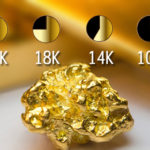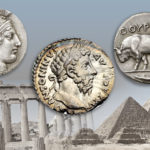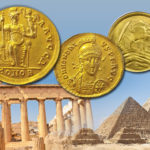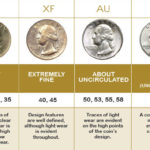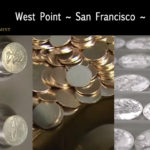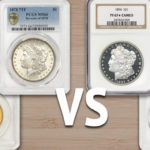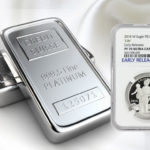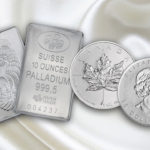Mint State Gold
-
What is a Karat? What is AGW?
Updated November 6th 2017 What Is a Karat of Gold? Understanding gold and its economy can sometimes feel very much like an insider’s game. Whether you’re talking to a salesperson, looking at an advertisement, or reading something on the internet, it can seem like there’s a lot of complicated language being thrown around. You’ve probably heard the term "gold karat...(Read More) -
How to Buy Silver - 3 Easy Steps
With over 50 years of being a professional wholesale silver investor and dealer, I have found it’s easy for a well informed silver buyer to quickly learn how to buy silver and get a good deal when adding silver to your portfolio. Buying silver investments for your precious metals portfolio is as easy as 1-2-3. Step #1 - Buy The...(Read More) -
History of Silver
Humans have been fascinated with Silver since recorded history began. In ancient Greece, Silver was associated with Isis, the goddess of motherhood and fertility. In the west, several pre-Columbian tribes buried their dignitaries in Silver to usher them into the next world. Silver appears as a symbol of strength and beauty in everything from Roman mythology to the ancient Hebrew...(Read More) -
History of Gold
(Read More)Since ancient times, no other substance on earth has been so desired, fought over, revered or mythologized as Gold. Gold has long been equated with power and beauty in virtually every culture. Gold has been written about in the biblical Book of Genesis and by Greek sage and poet Homer who warned of its allure. It is, perhaps, the only metal universally accepted as a form of wealth, long before the first coins were ever minted.
Mythological tales have been passed down from generation to generation surrounding Gold. Greedy King Midas was cursed with the Golden Touch and everything he touched was turned to Gold, including his beloved daughter. Jason and the Argonauts searched for the fabled Golden Fleece against Herculean odds, a mythological tale rooted in reality. Ancient miners used a sheep’s fleece as a type of sieve to capture the tiny, but heavy, flakes of Gold found in water. After the fleece dried, it was gently shaken and the Gold flakes were collected. This method was even practiced by some miners in the California Gold Rush of 1849.
-
Glossary
A | B | C | D | E | F | G | H | I | J | K | L | M | N | O | P | Q | R | S | T | U | V | W | X | Y | Z A ANA Abbreviation for the American Numismatic Association The...(Read More) -
Understanding the Point Grading Scale
(Read More)The table below shows each of the point scores on the modern Point Grading Scale along with their corresponding descriptive categories and abbreviations, and is followed by a list of detailed category explanations and defining characteristics.
Note: The Difference between Mint State and Proof Grades
The term “Mint State” is a grader’s designation for a regular Business Strike coin that has never been circulated: e.g. one in the same approximate condition as when it was first produced. A Mint State (MS) coin is graded between 60 (with marks) and 70 (flawless/gem-like)—the highest grade a Business Strike coin can achieve.
-
How Modern Coins are Made
(Read More)The earliest known examples of coins date back to 7th century Turkey. They were irregular in shape, stamped on one side, and made from a gold-silver mix, known as electrum. The Greeks refined the minting process, and later the Chinese, who were the first to use non-precious metals in their coins—a practice that soon spread to the West and became common among developed countries. Coin manufacturing techniques continued to evolve throughout Western cultures up through the industrial revolution and the invention of high-powered presses. Since then, with the exception of computer advancements, the coin making process has remained relatively unchanged.
-
Investment Grade vs. Rare Coins
(Read More)Investment Grade Coins are one step away from Rare Coins. Investment Grade Coins are typically sold individually or in rolls, and with the passing years have proven stronger returns. Investment Grade Coins are also of great quality and are scarce, which means they have strong investor demand! Usually, there are also certified gold and silver coins in a holder. To learn more about why coins are graded and placed in holder please click here.
-
Platinum
(Read More)To gain an understanding of how rare Platinum is, consider this… all the Platinum ever mined could fit in the living room of an average sized home! It’s also scarce. While Gold is relatively abundant in many parts of the world, large Platinum deposits have only been found in two places; South Africa and the Ural Mountains of Russia. 10 tons of ore must be removed from the earth and painstakingly processed to yield a single ounce of this precious metal. It has been sought after by everyone from the ancient Egyptians to Louie the 16th, who proclaimed it, “the only metal fit for royalty”. It’s the ideal metal for jewelry because Platinum is so hard; many claim it never wears down. Because of these qualities, it’s no wonder Platinum is often referred to as “The Rich Man’s Gold”. And many industries have found this precious metal beneficial as well.
Besides jewelry, Platinum can be found in laboratory equipment, electrical contacts, electrodes, thermometers and dentistry equipment. Over one-third of all Platinum mined and processed each year is used in catalytic converters for automobiles. The increased automobile emission standards around the world now require auto manufacturers to use more and more Platinum in catalytic converters. Watchmakers appreciate the unique properties of Platinum because it neither tarnishes nor wears out. Rolex, Breitling, and other famed watch companies use Platinum for producing their limited edition watch series. Some compounds, found only in Platinum, are even used in chemotherapy for cancer patients.
-
Palladium
(Read More)Palladium has a unique history. It is one of the only precious metals not initially used in jewelry… but medicine. Discovered in 1803 by British chemist and metallurgist, William Hyde Wollaston, who named Palladium after the asteroid Pallas that had been discovered two years earlier. Wollaston mixed Palladium with other chemical compounds and used it as a treatment for tuberculosis. It did have some negative side effects and was later replaced. But since it’s a sister metal to Platinum, manufactures quickly found use for it beyond medicine.
Palladium is now used in computers, mobile phones, LCD televisions, surgical instruments, aircraft spark plugs, chemicals, dentistry and electrical contacts. Palladium is very similar to Platinum in appearance and industrial uses. The main difference between the two is price – Palladium is less expensive due to lower demand. Palladium does not tarnish or deteriorate with exposure to air, so automotive companies around the globe have used this precious metal in catalytic convertors.


